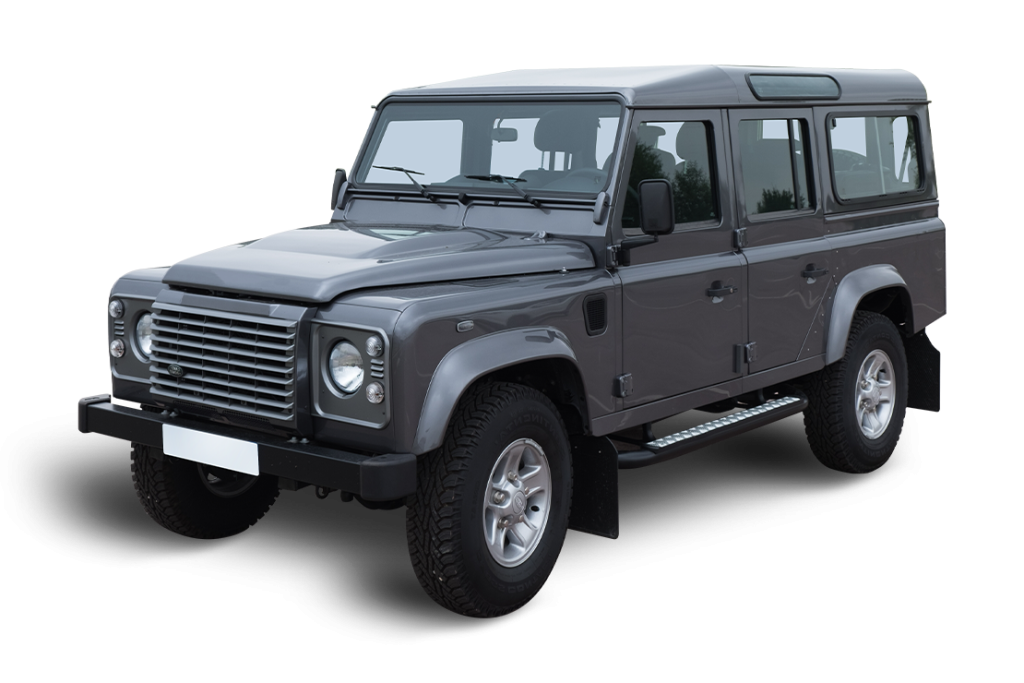The 110 was launched in 1983, and the 90 followed in 1984. From 1984, wind-up windows were fitted, and a 2.5 liter, 68 horsepower (51 kW) diesel engine was introduced. This was based on the earlier 2.3-liter engine, but had a more modern fuel-injection system as well as increased capacity. A low compression version of the 3.5 liter V8 Range Rover engine improved performance. It was initially available in the 110 with a Range Rover LT95 four-speed transmission with integral transfer case and vacuum operated differential lock, then later in conjunction with a high strength “Santana” five-speed transmission.
This period saw Land Rover market the utility Land Rover as a private recreational vehicle. While the basic pick-up, 4×4 and van versions were still working vehicles, the County 4x4s were sold as multi-purpose family vehicles, featuring improved interior trim and more comfortable seats. This change was reflected in Land Rover starting what had long been common practice in the car industry: detail changes and improvements to the County model from year to year in order to attract new buyers and to encourage existing owners to trade in for a new vehicle.

Defender 110 chassis
-
Defender 110 2.5 / 200 TDI Marsland chassis
€4.590,00 – €4.840,00Opties selecteren Dit product heeft meerdere variaties. Deze optie kan gekozen worden op de productpagina -
Defender 110 300 TDI Marsland chassis
€4.590,00 – €4.840,00Opties selecteren Dit product heeft meerdere variaties. Deze optie kan gekozen worden op de productpagina -
Defender 110 V8 Marsland chassis
€4.590,00 – €4.840,00Opties selecteren Dit product heeft meerdere variaties. Deze optie kan gekozen worden op de productpagina -
Defender 110 TD5 Marsland chassis
€4.590,00 – €4.840,00Opties selecteren Dit product heeft meerdere variaties. Deze optie kan gekozen worden op de productpagina -
Defender 110 TD4 / PUMA TDCI Marsland chassis
€4.590,00 – €4.840,00Opties selecteren Dit product heeft meerdere variaties. Deze optie kan gekozen worden op de productpagina
Land Rover Defender 90 and 110
Production of the model now known as the Defender began in 1983 as the Land Rover 110, a name which reflected the 110-inch (2,800 mm) length of the wheelbase. The Land Rover 90, with 93-inch (2,362 mm) wheelbase, and Land Rover 127, with 127-inch (3,226 mm) wheelbase, soon followed.[8]
Superficially there is little to distinguish the post-1983 vehicles from the Series III Land Rover. A full-length bonnet, revised grille, plus the fitting of wheel arch extensions to cover wider-track axles are the most noticeable changes. Initially the conservative engineering department insisted that the Land Rover was also available with a part-time 4WD system familiar to derivatives produced since 1949. However, the part-time system failed to sell and was quickly dropped from the options list by 1984. While the engine and other body panels carried over from the Series III, mechanically the 90 and 110 were modernised, including:
- Coil springs, offering a more compliant ride and improved axle articulation
- A permanent four-wheel-drive system derived from the Range Rover, featuring a two-speed transfer gearbox with a lockable centre differential
- A modernised interior
- A taller one-piece windscreen
- A new series of progressively more powerful and modern engines
The Land Rover Defender (initially introduced as the Land Rover 110 / One Ten, and in 1984 joined by the Land Rover 90 / Ninety, plus the new, extra-length Land Rover 127 in 1985) is a series of British off-road cars and pick-up trucks. They consistently have four-wheel drive, and were developed in the 1980s from the original Land Rover series which was launched at the Amsterdam Motor Show in April 1948. Following the 1989 introduction of the Land Rover Discovery, the term ‘Land Rover’ became the name of a broader marque, and thus no longer worked as the name of a specific model; thus in 1990 Land Rover renamed the 90 and 110 as Defender 90 and Defender 110 respectively. The 127 became the Defender 130.
The vehicle, a British equivalent of the Second World War derived (Willys) Jeep, gained a worldwide reputation for ruggedness and versatility. Using a steel ladder chassis and an aluminium alloy bodywork, the Land Rover originally used detuned versions of Rover engines. The original Defender is still being produced in developing countries despite the arrival of the Land Rover Defender (L663).
Though the Defender was not a new generation design, it incorporated significant changes, compared to the series Land Rovers, such as adopting coil springs front and rear, as opposed to all leaf springs on the previous; except for retaining rear leaf springs on high capacity (payload) models. Coil springs offered both better ride quality and improved axle articulation. Adding a lockable centre differential to the transfer case gave the Defender permanent (on-road) four-wheel-drive capability. Both changes were derived from the Range Rover, and the interiors were also modernised.
Externally, a full-length bonnet and full-width integrated grille and headlights, combined with (finally) a single-piece windscreen, plus widened wheel arches that covered new, wider-track axles were the most noticeable changes. Initially the engineering department conserved a part-time 4WD system, like on previous models, but it failed to sell any longer, and this option was immediately dropped in 1984. While the engine was carried over from the Series III, a new series of modern and more powerful engines was progressively introduced.
Even when ignoring the series Land Rovers and perhaps ongoing licence products, the 90/110 and Defender models’ 33-year production run were ranked as the sixteenth longest single-generation car in history in 2020.[3]
In 2020, Jaguar Land Rover introduced the first all new generation of Land Rover Defenders, switching from body on chassis to integrated bodywork and from live, rigid axles to all around independent suspension. The range was originally limited to just two wheelbase lengths before a third, the Defender 130, was announced in 2022. The new Defender series is only available in closed, estate car bodies.






